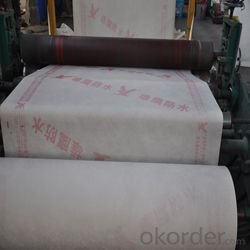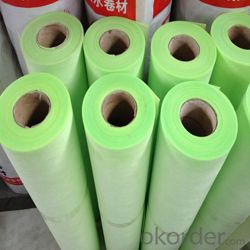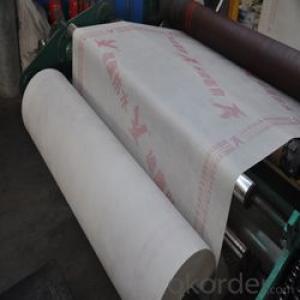High polymer PP and PE waterproof membrane
- Loading Port:
- Qingdao
- Payment Terms:
- TT OR LC
- Min Order Qty:
- -
- Supply Capability:
- 1100000 m²/month
OKorder Service Pledge
OKorder Financial Service
You Might Also Like
High Polymer polyethylene polypropylene composite
waterproof membrane
PP+PE+PP composite waterproof membrane is made by multipleply different materials,
especially its aging and weathering resistance layer enables the membrane possess
more longer effective age. It can bond with many kinds of adhesions, firm and secure.
In case of cement-base, cementations agent can be used, the cementationsagent
can easily enter into the non-woven felt layer, forms a well-combination with cement
after solidification, permanent durability.
1.Specifications:
2.Core Material: PE, EVA
3.Color: black, white, green, grey
4.Weight: 300g/m2-800g/m2
5.Length: 100M, 50M
6.Width: 1.15M, 1.20M, 1M
7.Thickness: 0.6mm-1.5mm
8.Technics: Heat synthesis
9.Payment: T/T
10.Port: Qingdao
11.Origin: CHINA
12.Packaging & Delivery: Packed in roll, will deliver after 7-14 days after receive the prepayment

Characteristic:
1. Non-toxic, no pollution, environmental protecting product.
2. Can be used for many different surfaces, especially for cement basement.
3. Tough, impermeable, multi-layered sheet;
4. High tension strength, good cold flexibility.
Application:
Products used in roofing, basement, restroom, water conservation, warehouse to
protect structure from water infiltration.
Construction:
1.The application is simple and no-pollution. It is mainly used in the middle of building
for waterproofing. On this layers of protection and decoration are needed;
2. When application, pour the adhesive materials homogeneously on the smooth roof
deck, then roll the membrane to make is fully adhered to the deck.
3. The adhesive materials are usually made form cement or other building glue

- Q:Can a waterproofing membrane be used on stadium seating areas?
- Indeed, stadium seating areas can benefit from the application of a waterproofing membrane. Typically utilized to shield structures from water-related harm, such as roofs, basements, and decks, waterproofing membranes prove invaluable. Stadium seating areas, being frequently exposed to the elements like rain and snow, are susceptible to water damage if not adequately safeguarded. The implementation of a waterproofing membrane effectively thwarts water infiltration, thereby averting potential predicaments including mold proliferation, material deterioration, and structural impairment. It is crucial to select a top-notch waterproofing membrane specifically formulated for outdoor usage, capable of enduring heavy foot traffic, thus guaranteeing enduring protection for the stadium seating areas.
- Q:Can a waterproofing membrane be used in historic buildings?
- Yes, a waterproofing membrane can be used in historic buildings. However, it is important to consider the specific needs and requirements of the building. The use of a waterproofing membrane should be carefully assessed and integrated into the building's preservation and conservation plans to ensure compatibility with its historic fabric and materials. Professional advice and expertise should be sought to ensure the appropriate selection and installation of the waterproofing membrane without compromising the building's historic integrity.
- Q:Can a waterproofing membrane be used for retaining walls?
- A waterproofing membrane is suitable for retaining walls as it helps to prevent water from penetrating and causing damage or structural failure. These membranes, made of materials like rubber, PVC, or bituminous compounds, are installed on the inner side of the retaining wall to create a barrier against water infiltration. In addition to protecting the wall's stability, some membranes also offer resistance to root penetration, UV protection, and flexibility to accommodate movement. However, it is crucial to consider factors such as the type of retaining wall, water pressure, and local climate conditions when selecting the right waterproofing membrane. It is advisable to consult with a professional engineer or contractor to ensure the most suitable waterproofing solution for your specific retaining wall project.
- Q:Does a waterproofing membrane provide any soundproofing benefits?
- No, a waterproofing membrane does not provide any soundproofing benefits. Its primary function is to prevent water penetration and protect against moisture damage. Soundproofing requires specific materials and techniques designed to absorb, block, or isolate sound waves.
- Q:How does a waterproofing membrane adhere to a variety of surfaces?
- A waterproofing membrane adheres to a variety of surfaces by utilizing a strong adhesive backing or by being applied with a suitable adhesive. This allows it to bond effectively to different materials such as concrete, wood, metal, or even existing waterproofing layers. Additionally, some membranes may also have self-adhesive properties that eliminate the need for an external adhesive.
- Q:How to distinguish the degree of sbs waterproofing membrane?
- Method 3: If you do not want to send the laboratory, you can do the test in the refrigerator, as long as the refrigerator can meet the requirements of low temperature on the line. Method to refer to GB 18242 (2008) "elastomer modified asphalt waterproofing membrane". This method can only know the approximate situation of the coil.
- Q:How does a waterproofing membrane adhere to the surface?
- A waterproofing membrane adheres to the surface through a combination of mechanical and chemical bonding. The membrane is typically applied using a specialized adhesive or primer that helps create a strong bond between the membrane and the surface it is being applied to. The mechanical bonding occurs as the adhesive or primer penetrates into the pores of the surface, creating a physical bond between the membrane and the substrate. This helps ensure that the membrane is securely attached and able to withstand the forces it will encounter. Chemical bonding also plays a crucial role in the adhesion process. The adhesive or primer contains chemicals that react with the surface, forming chemical bonds with the membrane. This chemical reaction helps create a durable and long-lasting bond that can withstand environmental factors such as temperature changes, moisture, and UV exposure. Additionally, the composition of the waterproofing membrane itself plays a role in its adhesion. Many membranes are made of materials with inherent adhesive properties, such as bitumen or rubberized asphalt. These materials have natural tackiness, which allows them to adhere to the surface without the need for additional adhesives or primers. Overall, the adhesion of a waterproofing membrane to a surface is a combination of mechanical and chemical bonding, achieved through the use of specialized adhesives or primers. This ensures a strong and durable bond that effectively protects the surface from water damage.
- Q:Can a waterproofing membrane be used in areas with extreme temperatures?
- Indeed, in areas with extreme temperatures, it is possible to utilize a waterproofing membrane. Numerous waterproofing membranes are specifically crafted to endure a vast spectrum of temperatures, ranging from scorching hot to freezing cold. These membranes are manufactured using materials that exhibit resistance against cracking, melting, or brittleness when exposed to extreme temperatures. Moreover, certain waterproofing membranes are specially engineered for deployment in regions with extreme temperatures, such as arctic or desert environments. To guarantee efficacy and durability, it is crucial to select a waterproofing membrane that aligns with the specific temperature range of the intended area of use.
- Q:Can a waterproofing membrane be used on tunnels with architectural features?
- Indeed, tunnels with architectural features can benefit from the application of a waterproofing membrane. Such membranes possess versatility, enabling their usage on different structures, including tunnels with architectural elements. Their primary purpose is to establish a protective barrier against water infiltration, consequently safeguarding the structure against moisture-related harm. Regardless of the tunnel's unique architectural components, such as curves, arches, or decorative embellishments, a tailored waterproofing membrane can be tailored and implemented to ensure optimal water resistance. Therefore, it is imperative to seek guidance from a proficient waterproofing specialist experienced in working with tunnels and architectural features. They will assist in determining the most suitable membrane system for the specific project prerequisites.
- Q:Can a waterproofing membrane be used in conjunction with paint or coatings?
- Yes, a waterproofing membrane can be used in conjunction with paint or coatings. The membrane provides a barrier against water intrusion, while the paint or coatings provide additional protection and aesthetic appeal.
1. Manufacturer Overview |
|
|---|---|
| Location | |
| Year Established | |
| Annual Output Value | |
| Main Markets | |
| Company Certifications | |
2. Manufacturer Certificates |
|
|---|---|
| a) Certification Name | |
| Range | |
| Reference | |
| Validity Period | |
3. Manufacturer Capability |
|
|---|---|
| a)Trade Capacity | |
| Nearest Port | |
| Export Percentage | |
| No.of Employees in Trade Department | |
| Language Spoken: | |
| b)Factory Information | |
| Factory Size: | |
| No. of Production Lines | |
| Contract Manufacturing | |
| Product Price Range | |
Send your message to us
High polymer PP and PE waterproof membrane
- Loading Port:
- Qingdao
- Payment Terms:
- TT OR LC
- Min Order Qty:
- -
- Supply Capability:
- 1100000 m²/month
OKorder Service Pledge
OKorder Financial Service
Similar products
New products
Hot products
Related keywords































